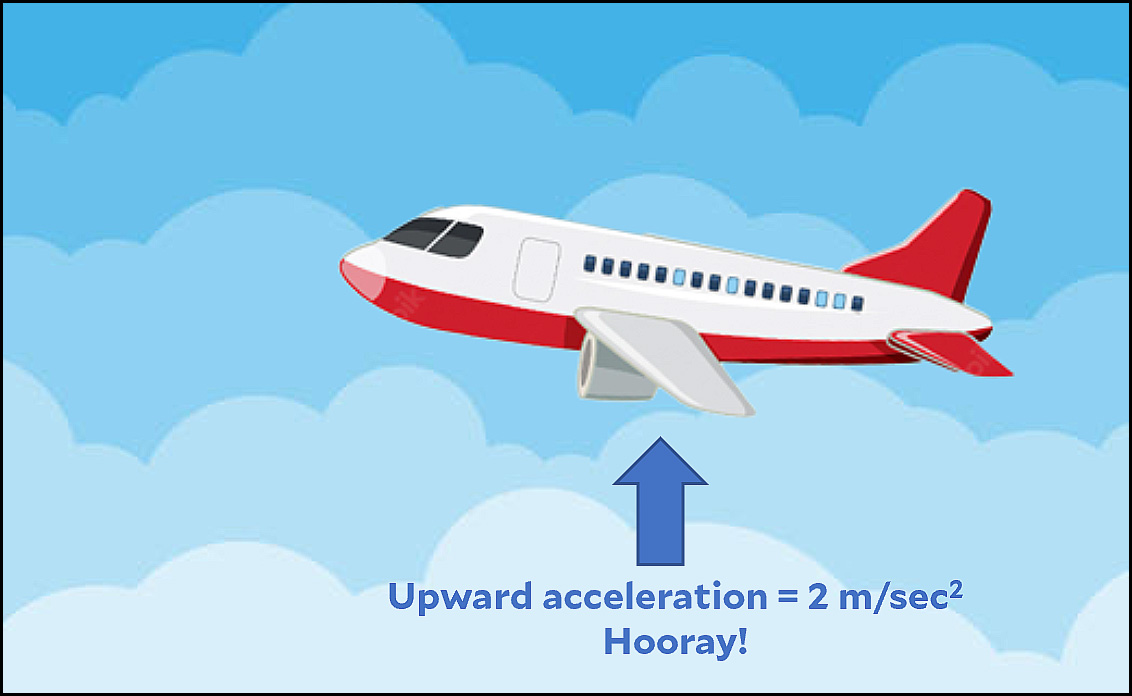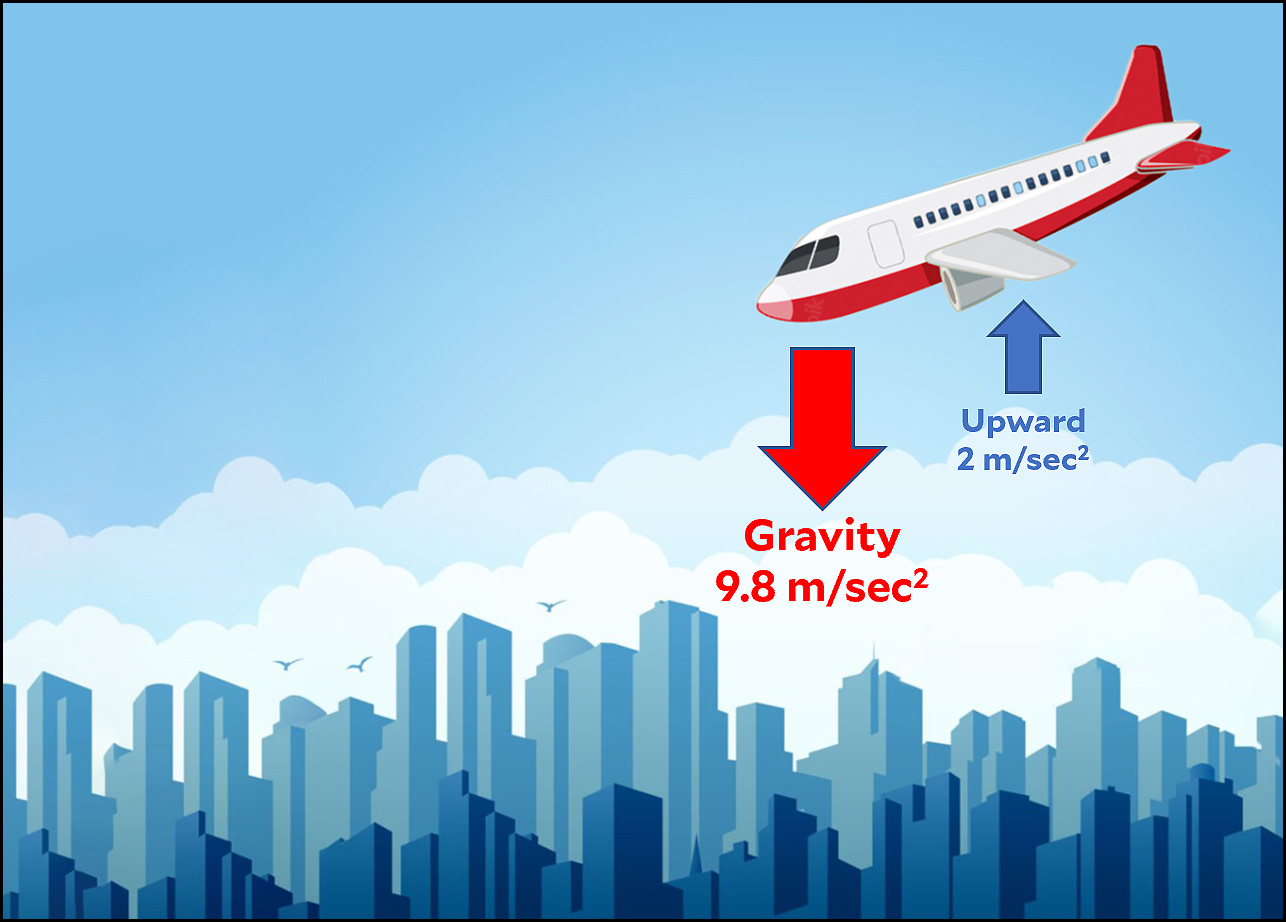A reader asked me today to explain my analogy of inflation to the law of gravity. It's simple. Here's a picture of an airplane. Lift is providing an upward acceleration of 2 meters/sec², so everything is hunky dory.
 But wait. We need to adjust for the downward force of gravity:
But wait. We need to adjust for the downward force of gravity:
 Once we've done that, the real acceleration of the airplane is 7.8 meters/sec² straight down.
Once we've done that, the real acceleration of the airplane is 7.8 meters/sec² straight down.
There are occasions when you don't care about gravity and you only want to know about lift—for example, if you're testing a model in a wind tunnel. But in nearly all real-world applications, you need to adjust prices for inflation and you need to adjust the aerodynamic lift of an airplane for gravity. If you don't, your view of reality is faulty and you're going to crash and burn.

Holy crap… this analogy is absurdly bad, since physics doesn’t even remotely work like this. Suffice it to say, a plane accelerating up at 2m/s^2 is not actually falling, which is what Kevin is saying here.
Jeebus.
He's not saying that the net upward acceleration on the plane is 2 m/s^2, he's saying that aerodynamic lift is providing an upward acceleration of 2 m/s^2.
It is still wrong. It is in effect saying that the "real" acceleration is due to gravity but is partly being counteracted by another acceleration. Physics doesn't work like that. You can add forces but you cannot add accelerations. That is because acceleration is a measurable thing and there is only ever one value for it at a time. There is a net force, but there is no such thing as a net acceleration.
F = MA
F is a vector, M is a scalar, therefore A is a vector. And yes, vectors can be added (following the rules of vector algebra) to produce a resultant net vector.
Start making more money weekly. This is valuable part time work for everyone. The best part ,work from the comfort of your house and get paid from $10k-$20k each week . Start today and have your first cash at the end of this week.
Visit this article for more details.. https://Payathome.pages.dev/
I had an issue with the comparison to the law of gravity more on the grounds that gravity is quantifiable in absolute terms and that it is, as far as these things go, actually a law.
Inflation is nothing like that. They're literally only alike in this one specific way that Kevin is talking about, which is that you need to adjust prices/currency amounts for inflation (in most cases).
Um . . . no?
A single object only ever has a single acceleration, determined by the net force acting on it. You do not add accelerations. I've lost count of the number of students who stand motionless in front of me and confidently assert that their acceleration is currently 9.8 m/s^2 because gravity. When I ask why they are not moving, it is because the floor is blocking their motion.
This is a phenomenological primitive and you can find an extended discussion of these and what is wrong with them in Andrea diSessa's 1993 paper Toward an Epistemology of Physics. You can also find it implicitly in textbooks by authors who should know better.
I thought the ground was accelerating us against curved spacetime, which accounts for the time dilating effect of gravity? Not arguing, happy to be corrected.
Acceleration is a vector, so yes the magnitude of that vector is a single value, but it is possible for a body to be accelerating in two different directions when two different forces are applied to it. The airplane in Kevin's example is not sitting on the floor. If the wings suddenly came off it would accelerate downward at 9.8 m/sec2 (neglecting air resistance of the wingless fuselage).
OK, how about pointing out that lift contributes an upward force of F1 and gravity contributes a downward force of F2 and the net force is F1 - F2 which in Kevin's example is net negative, contributing to downward acceleration. Of course you have to factor in drag contributed by the presence of air, which will ultimately result in the airplane falling at some terminal velocity. And when there is total engine failure, that's what happens. There is some lift and there is gravity.
I personally don't see that this defines inflation, but I suspect Kevin is just pointing out that you need to consider inflation when you are making arguments about how wonderfully well the work force is doing under Republican governance etc.
My remembrance is that in places where there is a hard currency such as gold coins, there tends to be a deflationary drag on the economy because the mass of gold does not keep up with the number of humans in existence (in the long run). This is complicated by all manner of other things like the Gold Rush and Gresham's law effects and so forth. And these comments depend on a simple calculation where prices are determined by the total money supply and the total supply of goods and services. Obviously that is an incomplete model considering how the supermarkets and their suppliers did a little opportunistic marking up to take advantage of an inflationary moment during Covid. In a system where the money supply is adjusted to anticipate supplies and total demand, the government itself can generate a little inflation by printing too much money, or can create deflation by printing too little and/or by adjusting interest rates.
The experience of the past 75 years or so suggests that inflation can be kept lower than hyperinflation levels but it is hard to keep it right on the button at one percent for endless periods of time. But the second half of the 20th century was obviously better than the century before it.
Some commenters here are not too keen on KD's "Inflation is like gravity" comparison, but in the "Inflation is like ___" simile game you're allowed to FITB with anything you like. That apparently is the rule. For example:
Inflation is like toothpaste.
Inflation is like the tooth fairy, no really.
Inflation is like cancer.
Inflation is like sin.
Inflation is like alcoholism.
Inflation is like masturbation.
Inflation is like jumping off the top of the Empire State Building.
How about this: gravity is like capital. It attracts more capital increasing its mass and thus gravity this attracting more capital. Only very powerful forces can counteract this gravity. Outright thievery, whether legislative or physical, is one example.
err, I mean capital is like gravity.
I would ask chatGPT to write about it, but I already logged out and it has a timeout between sessions and it already takes a while to open up a new slot.
chat.openai.com
If you've used Dall-E, you log-in using the same credentials.
Truly terrible analogy. Truly apples and oranges.
The measured force of gravity is wildly different than the guesstimated rate of inflation.
Imagine if literally every object, every lo caction and every day presented a different force of gravity and we had no truly accurate way of measuring all these different gravities. Instead we come up with an average guesstimate which at times uses 6 month old data and includes a fudge factor to capture if the force of gravity makes the situation better or worse.
Given all this, imagine trying to apply this guesstimate gravity to literally every chart, graph and conversation.
oh goodness, it would be useless, dangerous and a waste of time in most situations. This faith based value might make you feel good, but it wouldn't help airline passengers or rocket payloads.
Didn't occur to me earlier, but inflation is backward looking, it provides no guidance on where you are today nor where you will be in the future.
I know exactly where I am today with nominal figures, and inflation adjustments don't provide any guidance about the future or planning for the future.
Instead, inflation adjustments allow me to do rough and inexact comparisons to the past often only at a macro, 30,000 foot level.
This is not similar to gravity at all. This bad analogy does help explain why Kevin insists on misapplying inflation adjustments at all times.
Inflation is the first derivative of prices with respect to time, and acceleration is the second derivative of distance with respect to time. Neither is “backward” looking in its pure sense, depending only on the instantaneous rate of change. Inflation only appears backward looking because of the press’s and the fed’s insistence on using the misleading definition of inflation as the price change over an arbitrary and misleading 12 months.
+1
I agree it’s a bad analogy, but I’m curious to know what you consider Kevin’s misapplications of inflation adjustment ‘at all times’. Certainly, the measures are imperfect, but they are not useless.
By the way, nominal measures of all but the tiniest economic sectors (e.g. your paycheck) are noisy, too.
But if analogies from physics bother you, note that some commenters here, and pundits elsewhere, seem to think that prices possess inertia; that if they rose last month, they must necessarily rise this month and next month, unless opposed by some ‘force’. Wrong.
was a reply to jdubs
This morning at Queen of Stupid High School.
https://www.rawstory.com/lauren-boebert-and-marjorie-taylor-greene-2659266219/
“What happens in the ladies room stays in the ladies room,”
Kevin:
How much did you pay for your house? What year did you buy it?
Now, quickly, what is the inflation adjusted price of your house? Do you update the inflation adjusted price every month?
I remember in 1978 my father saying he wasn't sure he could afford $100,000 mortgage in San Francisco. Imagine buying a decent house for $150,000.
Of course, I am not crazy enough to inflation adjust it.
Actually, this is not EXACTLY right because you need the sign. When you are on the ground waiting to board, your acceleration is -9.8 m/s2 due to gravity (otherwise you would fly off into space, without an airplane, due to the rotation of the earth.). When you are on the plane and it's climbing, your net acceleration is -7.8 m/s2. And when you reach cruising altitude, it then drops to -9.8 m/s2 so you continue to follow the curve of the earth. When you start to descend (at -2 m/s2), your total acceleration becomes -11.8 m/s2 until you land, and then it increases to good old 9.8 m/s2 once again.
Ouch, no! This is why one ought to do the vector math with forces, then calculate the acceleration along the net force vector. Standing in line in the terminal, displacement is constant, so acceleration (2nd derivative of displacement) is 0. You are acted on by a force = -9.8 m/s^2 x (your mass in kg) Newtons, and the resistance of the floor = +9.8 m/s^2 x (your mass in kg) Newtons. As the aircraft’s climb rate increases at +2 m/s^2, the seat resists with force = -9.8 m/s^2 x (your mass in kg) Newtons + -2 m/s^2 x (your mass in kg) Newtons; net force = -11.8 m/s^2 x (your mass in kg) Newtons, or ~1.2 g.
Solving for the descent phase is left as an exercise …
Oh, damn, messed up the signs copying and pasting …